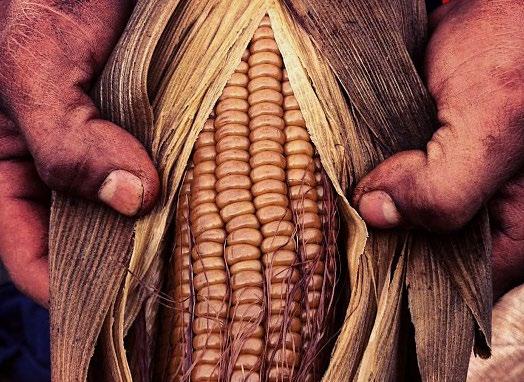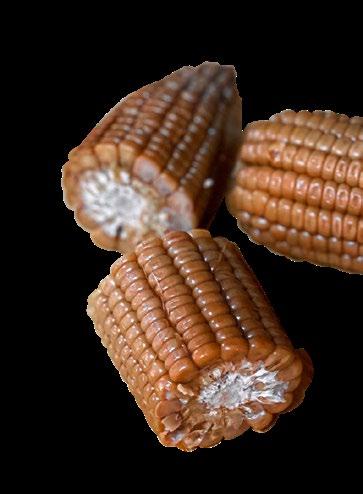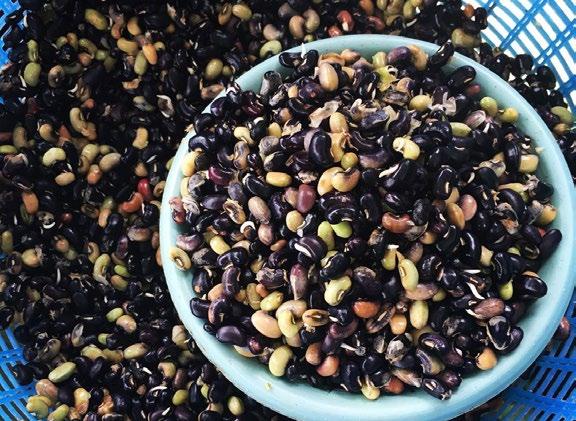
6 minute read
Explorando
el auténtico sabor del elote yucateco
El maíz en la cultura maya tenía un papel fundamental, ya que éste era la base de su alimentación. Los mayas veneraban a Yum Kaax, dios de la agricultura y el maíz, debido a que una gran mayoría de los ancestros se dedicaban a la agricultura. De acuerdo con el Popol Vuh, las deidades crearon a los humanos para que éstos les rindieran culto, luego de varios intentos fallidos, la humanidad fue creada a partir del maíz.
Advertisement
El comer y degustar de un exquisito elote es uno de los tantos placeres que hay en la vida. ¿Sabías que existe un elote que tiene un auténtico sabor yucateco por su método de cocción? A estos elotes se les conoce como “pibinales”. El elote pibinal pertenece a la extensa gastronomía yucateca. El significado de su nombre es “elote enterrado” haciendo referencia a su técnica de preparación porque la palabra “pibinal” se deriva de los vocablos mayas “píib” (asar debajo de la tierra, horno subterráneo) y “nal” (elote, mazorca). Los elotes pibinales se caracterizan por su sabor dulce y ahumado al mismo tiempo, y por su característica tonalidad café que adquieren cuando se están cocinando. Este tipo de elote es una clara manifestación gastronómica que proviene de las raíces culinarias de nuestros antepasados, dándole así un verdadero valor gastronómico. Los campesinos preparan los pibi-
nales como muestra de agradecimiento a los dioses del monte (Yum Dzules) por las buenas cosechas que obtienen.
Comúnmente se suele degustar un rico pibinal en las fechas del día de muertos yucateco, el Hanal Pixán. Generalmente, los pibinales son vendidos por las mestizas en los mercados en bolsas para que los marchantes puedan comprarle y así poder disfrutar de estos típicos, deliciosos y ancestrales elotes cosechados en la región yucateca.
Pibinal, The Authentic Flavor of Yucatecan Corn
Corn plays a fundamental role in Maya culture. It was, and is, the basis of the region’s diet. The Maya worshiped Yum Kaax, god of agriculture and corn; a large large majority of their ancestors were dedicated to agriculture. According to the Popol Vuh, the sacred book of the Maya, the gods, after several failed attempts, created humans so that we would worship them. The gods created us from corn.
Eating and tasting an exquisite corn dish is one of the many pleasures in life. Did you know that there is a corn that has an authentic Yucatecan flavor due to its cooking method? These corn are known as pibinales.
Elote pibinal, or Pibinal Corn, belongs to the extensive Yucatecan gastronomy. The meaning of its name is “buried corn,” referring to its preparation technique because the word pibinal is derived from the Mayan words piib, meaning to roast underground or an underground oven; and nal, meaning corn cob. Elotes pibinales are characterized by their simultaneous sweet and smoky flavor and by their distinctive brown hue that they acquire when they are being cooked. This type of corn is a clear gastronomic dish that comes from the culinary roots of our ancestors, meaning it’s a true gastronomic legacy. Country folk prepare the pibinales as a token of gratitude to the mountain gods (Yum Dzules) in order to assure good harvests.


Commonly, a delicious pibinal is prepared for Hanal Pixán, how the “Day of the Dead” is celebrated among the Yucatec Maya. Women in municipal markets usually sell pibinales in bags, allowing consumers to buy them and have the these traditional, delicious and ancestral elotes harvested in the Yucatecan region.
El espelón,
el delicioso frijol yucateco
La gastronomía yucateca es mundialmente reconocida gracias a sus sabores, aromas e ingredientes ancestrales, herencia culinaria de los antepasados. Empieza la cuenta regresiva en este mes de octubre, el tan ansiado mucbipollo o pib, platillo principal del día de muertos yucateco, el Hanal Pixán, saciará el “poch” (del maya pooch que significa antojo) de los yucatecos y de los que residen en estas hermosas tierras. En algunas ocasiones y dependiendo del gusto de la persona, a este tamal yucateco se le agrega otro ingrediente: el espelón.
Del maya x´pelón, x péelón, el espelón es un frijol que se cultiva en suelo yucateco y en gran parte de la Península de Yucatán. Este frijol suele tener presencia en los platillos yucatecos, como ya se mencionó al principio, al pib se le agregan los granos. De igual manera, a los vaporcitos yucatecos (otro tipo Yucatecan gastronomy is world renowned thanks to its ancestral flavors, aromas, and ingredients, culinary inheritance of the ancestors. As we begin to count the days until the feasts honoring the dearly departed, the long-awaited mucbipollo or pib, forms the main dish of the Hanal Pixán, how “Day of the Dead” is celebrated in the Yucatán, is a dish that will satiate your craving, or poch, in Yucatec Maya, as this dish does for those who live in our beautifal lands. On some occasions—and depending on the preference of the person—another ingredient is added to this Yucatecan tamale: the espelón.
From the Maya x’pelón or x péelón, the espelón is a bean, similar to the familiar black bean, that is native to the Yucatán and grown widely throughou the peninsula.
This bean usually has a presence in Yucatecan dishes, as already mentioned at the beginning, these beans can be added to the pib.
In the same way, this bean can be added to the Yucatecan or vaporcitos tamales. (A vade tamal) se le añade el espelón. Ambos tamales se cocinan unos días antes del Hanal Pixán para que sean la ofrenda en los altares y recordar a los fieles difuntos.
Desde semanas antes, los campesinos y mestizas venden las vainas de este alimento en los mercados de Mérida y en los municipios, ya sea en presentación de manojos o embolsados. Las vainas pueden llegar a medir 20 cm de largo, en su interior están los granos negros, en ocaporcito is a kind of tamale that is steamed.)
Both tamales are cooked a few days before
Hanal Pixán and then are served as an offe-

siones tienen una apariencia y tonalidad púrpura. La gran diferencia que radica en este tipo de frijol, es que se debe cocinarse cuando todavía está tierno, es decir, después de las 5 semanas de su cosecha, pierde sus cualidades y al ya no estar en excelentes condiciones, prácticamente el espelón queda inservible. Por esa razón se cultiva durante el mes de octubre para que se preparen el pib y los vaporcitos.
The Espelón, the delicious Bean of Yucatán

Editorial completa en explore.mx ring on the altars and to remember the deceased.
Weeks before this, country folk and the women sell the pods this food in the markets throughout Mérida and in other municipalities. They are sold either in bundles or in bags. The pods can be 8 inches (20 centimeters) long. The black pods are inside; at times they have a purple hue.
The great difference is that this type of bean must be cooked when it is still tender, that is to say, no later than five weeks after being harvested. After that time, it loses its qualities and is no longer in excellent condition; the espelón becomes practically useless. For this reason, it is cultivated during the month of October, when the pib and the vaporcitos are prepared.






